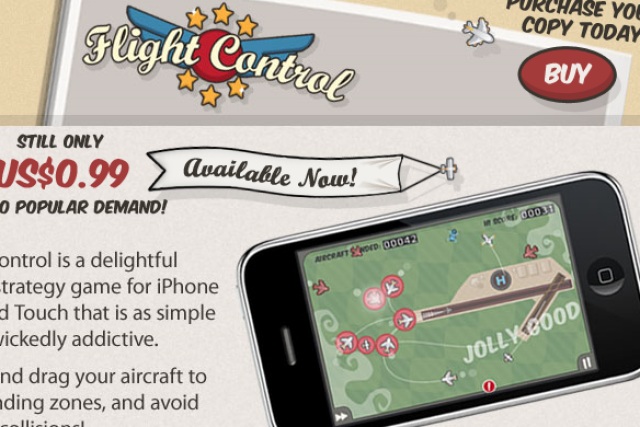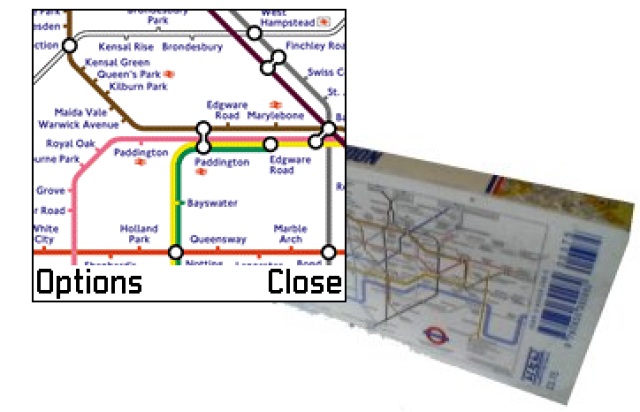We’ve had a little look around to come up with ten areas that you (the developer) might like to look at when you’re deciding on your new project for world domination Symbian.
The Line Drawing Genre
And I’m looking at Firemint’s Flight Control on the iPhone here, which pretty much defined the new genre of the line-drawing game. You have some sort of terrain, lots of vehicles coming in from the sides, and you have to draw their route to safety, avoiding crashing them into each other. Perhaps because of the majority of S60 5th Edition devices having resistive screens, this hasn’t had any good implementation on Symbian yet. A well implemented, properly designed line drawing game could do very well, and when you look at how many of the top paid applications in online stores are games, a new genre of game that's fresh to the platform should look very attractive.

Fifty Ways to Read Your Website
It may no longer be the sexy way to keep up with your web sites, but the potential of RSS is still there – grabbing just the information from a site and then reworking it so it can be displayed nicely on a small screen is still a great idea. There are still new angles of presentation (look at Flipboard turning news and links into a newspaper style layout), and a decent interface to Google Reader would be welcomed by many.
Red warrior needs food, badly
One of the most profitable games on the planet is World of Warcraft – a monthly subscription fee coming out of the pockets of millions of players is a fine way to earn a crust.
The strength of a decent role playing game, be it a standalone single player or a Massively Multiplayer Online version, is well known. Look at Nokia’s Pocket Kingdom on the N-Gage. While it was flawed in terms of execution, for those that stuck with it this was one of those games that aroused huge dedication and fanaticism. Capture that, and any developer can start leveraging the in-app purchase system that’s been introduced for some recurring revenue.



Make a phone your home
Nokia has always pushed the customisation potential of their handsets, and that has resulted in a huge industry of themes and ringtones – but it also has led to applications that help customise the UI and environment of a phone. Be it a reworked lock screen or a replacement for the task launcher, there is a lot of scope to take the basic interface presented in Symbian and provide a bundle of customisation options to users.
Helping people get things done.
One of the areas that Symbian has been traditionally weak on is the built-in personal information management (PIM) suites. While the underlying database for the Calendar (and associated To-Do lists) has a huge amount of information stored, this doesn’t make it to the screen. While there are some PIM replacement apps out there, this is an area which could be more popular with some smart thinking.
There are also opportunities for some other life management tools – I’d really like a simple timer application following the 10+2 principle, and anyone who spends time looking at GTD should see scope for many utilities.
Getting connected with the social networks
While Nokia’s new 'Social' client is going to take a lot of the potential out of this market, I think there’s still going to be opportunities for developers to make strong and targeted third party applications that talk to specific social networks (e.g. Gowalla).
A lot will depend on how easy the extensions to the new Social client are to develop, and if the social networks themselves will step up and make sure they are part of this system (or if Nokia have a dedicated programmer whose sole job is to make the extensions). The simple fact that the app has to be a one size fits all means that there will be scope for something more focussed.
Organising your notes and thoughts
Alongside the calendar application, the woeful Notes application in the current Symbian suite (even when augmented with Active Notes) doesn’t allow you to keep track of more than a few thoughts. There’s a lot can be done to organise text on a device, and there’s the added bonus of synchronisation either to a desktop or to a server in “the cloud.”
Treepad for Windows is one of my favourite electronic note takers, providing a mix hierarchical notes and organisation. That’s also been taken up by the java app Mobile Task Manager, but a full blown mobile app would be a great addition, certainly to my phone.



Keeping track of your money
It seems to have fallen down the list of must-have apps, but for a long time no mobile computing platform was complete unless it had an application that would let you track your spending and reconcile it every month with your bank statements. In this time of austerity it’s probably just as important a function.
If I’m honest, it’s not something i would want to trust to a cloud server (although I would want an export function from the app to my computer), but with the multitude of online services and digital banking, a fresh look at this space would be more than welcome.
How can I get where I’m going?
Ovi Maps is useful, but does it give you the time of the next train home from the local (to your position) station? Does it give you a reminder that a bus might be quicker to get to Oxford? With the amount of information available through online API’s, building information services around public transport not only gives you a connected application, but provides something that has a positive impact on the user’s life. And that's one of the best feelings for a developer.

Don’t Forget The Big Boys
There are a number of internet services that don’t yet have a Symbian client (or they’ve got such a basic version that it’s not really worth their effort to promote it). A brave developer might want to consider a Kindle Client, Dropbox interface or even an improved Evernote application. You get to have all the users pick up your client, but run the risk of having it superseded by an official version.
Still, if you want to make a name for yourself, this is a valid route.
Ewan Spence, AAS. 24Sept 2010
